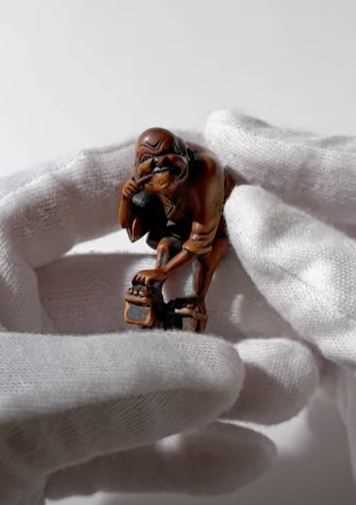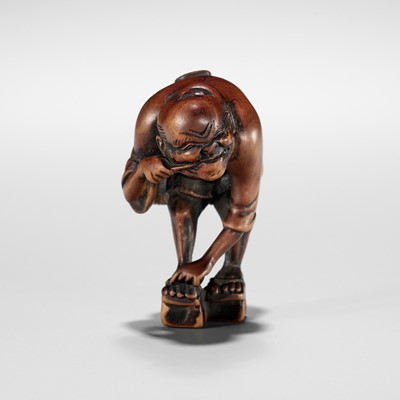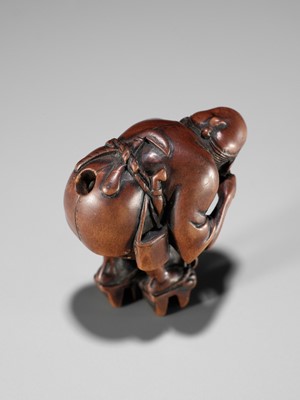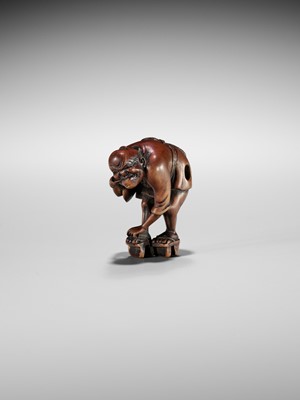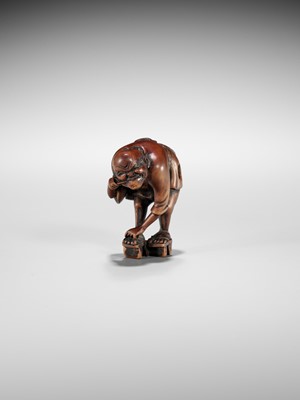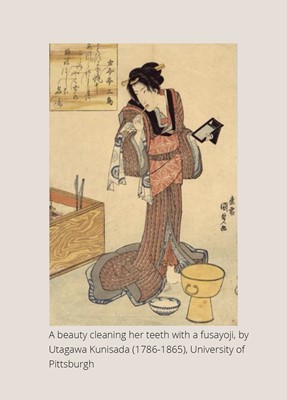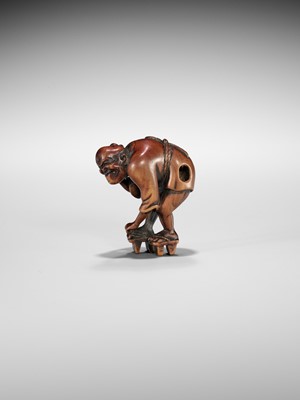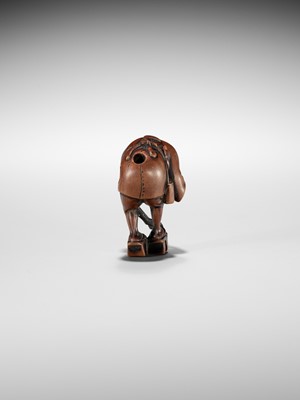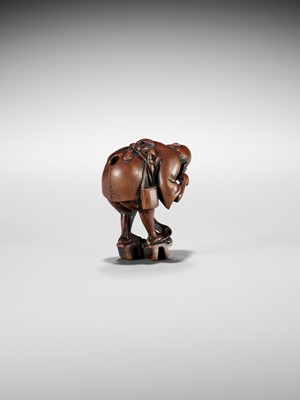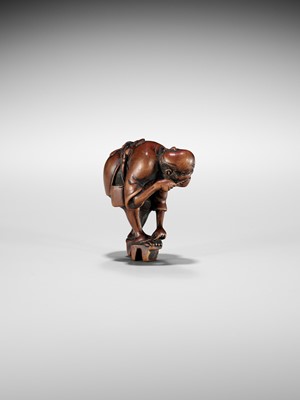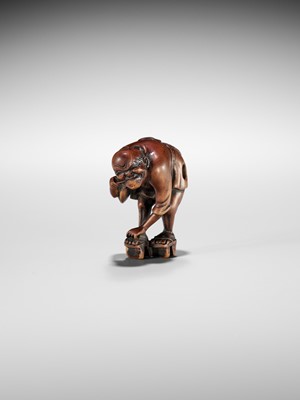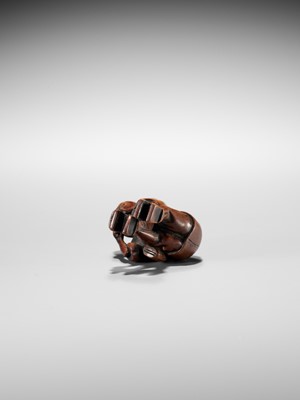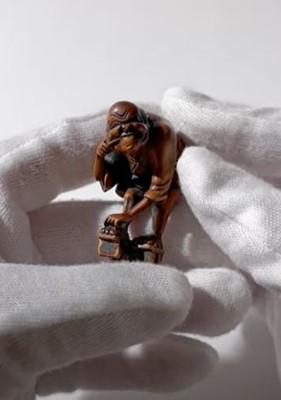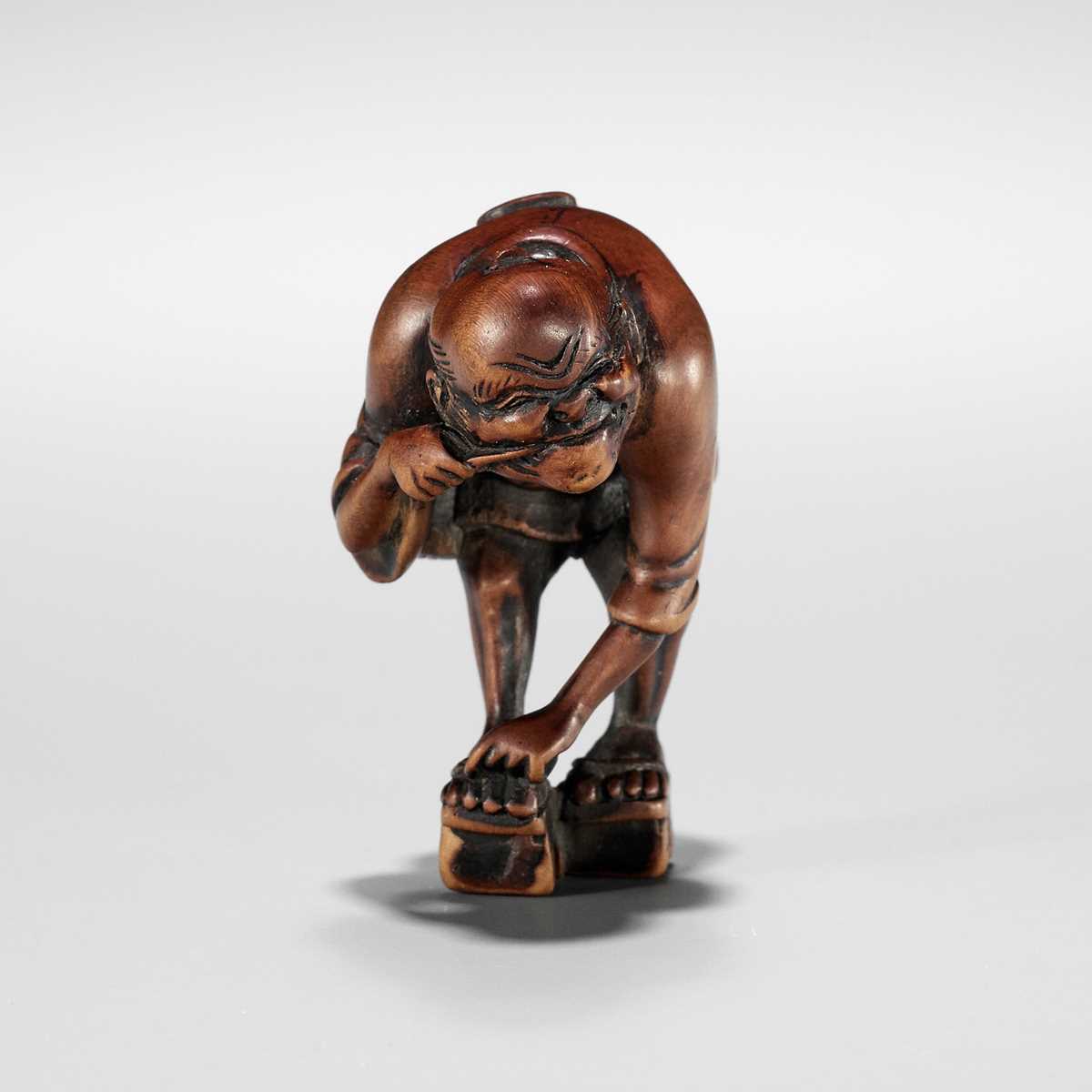16th Jun, 2023 11:00
Fine Japanese Art
284
AN EDO SCHOOL WOOD NETSUKE OF A FARMER TYING HIS GETA AND CLEANING HIS TEETH
Sold for €4,680
including Buyer's Premium
Unsigned
Japan, Edo (Tokyo), early to mid-19th century, Edo period (1615-1868)
The elderly man crouching to tie the strap on one of his geta sandals, wearing a short robe tied at the waist and suspending a tonkotsu (tobacco box) and kiseru (pipe), a sickle attached to his back, his face contorted in a grimace as he cleans his teeth using a fusayoji (tufted toothpick). The side and back with generously excavated, asymmetrical himotoshi, the larger of which is of oval shape.
HEIGHT 4.5 cm
Condition: Very good condition with minor wear and rubbing to patina.
Provenance: From the collection of Gaston Lazard (1878-1956) and his wife Jane Levy (1886-1985) and thence by descent within the same family.
Chew sticks are twigs or roots of certain plants that are chewed until one end is frayed. This end can be used to brush against the teeth, while the other end can be used as a toothpick. The earliest chew sticks have been dated to Babylonia in 3500 BC and an Egyptian tomb from 3000 BC. They are mentioned in Chinese records dating from 1600 BC, in the Ayurvedas around the 4th century BC and in Tipitaka, in the Buddhist Canon around the 5th century BC in India. The custom came to Japan with Buddhism and became popular during the mid-Edo period. Fusayoji (tufted toothpicks) were made from fragrant trees such as willow and black letters and were sold at shrine precincts.
Unsigned
Japan, Edo (Tokyo), early to mid-19th century, Edo period (1615-1868)
The elderly man crouching to tie the strap on one of his geta sandals, wearing a short robe tied at the waist and suspending a tonkotsu (tobacco box) and kiseru (pipe), a sickle attached to his back, his face contorted in a grimace as he cleans his teeth using a fusayoji (tufted toothpick). The side and back with generously excavated, asymmetrical himotoshi, the larger of which is of oval shape.
HEIGHT 4.5 cm
Condition: Very good condition with minor wear and rubbing to patina.
Provenance: From the collection of Gaston Lazard (1878-1956) and his wife Jane Levy (1886-1985) and thence by descent within the same family.
Chew sticks are twigs or roots of certain plants that are chewed until one end is frayed. This end can be used to brush against the teeth, while the other end can be used as a toothpick. The earliest chew sticks have been dated to Babylonia in 3500 BC and an Egyptian tomb from 3000 BC. They are mentioned in Chinese records dating from 1600 BC, in the Ayurvedas around the 4th century BC and in Tipitaka, in the Buddhist Canon around the 5th century BC in India. The custom came to Japan with Buddhism and became popular during the mid-Edo period. Fusayoji (tufted toothpicks) were made from fragrant trees such as willow and black letters and were sold at shrine precincts.
Zacke Live Online Bidding
Our online bidding platform makes it easier than ever to bid in our auctions! When you bid through our website, you can take advantage of our premium buyer's terms without incurring any additional online bidding surcharges.
To bid live online, you'll need to create an online account. Once your account is created and your identity is verified, you can register to bid in an auction up to 12 hours before the auction begins.
Intended Spend and Bid Limits
When you register to bid in an online auction, you will need to share your intended maximum spending budget for the auction. We will then review your intended spend and set a bid limit for you. Once you have pre-registered for a live online auction, you can see your intended spend and bid limit by going to 'Account Settings' and clicking on 'Live Bidding Registrations'.
Your bid limit will be the maximum amount you can bid during the auction. Your bid limit is for the hammer price and is not affected by the buyer’s premium and VAT. For example, if you have a bid limit of €1,000 and place two winning bids for €300 and €200, then you will only be able to bid €500 for the rest of the auction. If you try to place a bid that is higher than €500, you will not be able to do so.
Online Absentee and Telephone Bids
You can now leave absentee and telephone bids on our website!
Absentee Bidding
Once you've created an account and your identity is verified, you can leave your absentee bid directly on the lot page. We will contact you when your bids have been confirmed.
Telephone Bidding
Once you've created an account and your identity is verified, you can leave telephone bids online. We will contact you when your bids have been confirmed.
Classic Absentee and Telephone Bidding Form
You can still submit absentee and telephone bids by email or fax if you prefer. Simply fill out the Absentee Bidding/Telephone bidding form and return it to us by email at office@zacke.at or by fax at +43 (1) 532 04 52 20. You can download the PDF from our Upcoming Auctions page.
How-To Guides
How to Create Your Personal Zacke Account
How to Register to Bid on Zacke Live
How to Leave Absentee Bids Online
How to Leave Telephone Bids Online
中文版本的操作指南
创建新账号
注册Zacke Live在线直播竞拍(免平台费)
缺席投标和电话投标
Third-Party Bidding
We partner with best-in-class third-party partners to make it easy for you to bid online in the channel of your choice. Please note that if you bid with one of our third-party online partners, then there will be a live bidding surcharge on top of your final purchase price. You can find all of our fees here. Here's a full list of our third-party partners:
- 51 Bid Live
- EpaiLive
- ArtFoxLive
- Invaluable
- LiveAuctioneers
- the-saleroom
- lot-tissimo
- Drouot
Please note that we place different auctions on different platforms. For example, in general, we only place Chinese art auctions on 51 Bid Live.
Bidding in Person
You must register to bid in person and will be assigned a paddle at the auction. Please contact us at office@zacke.at or +43 (1) 532 04 52 for the latest local health and safety guidelines.
